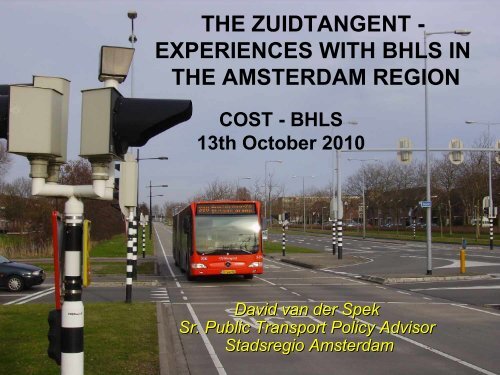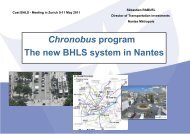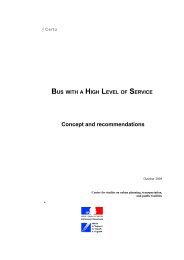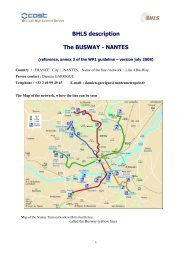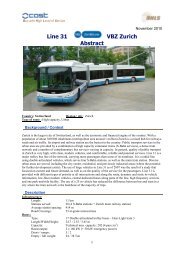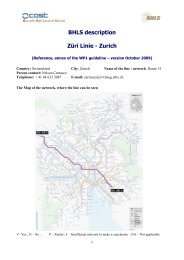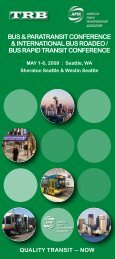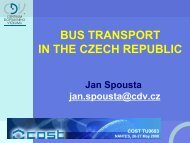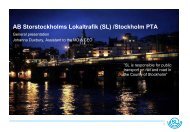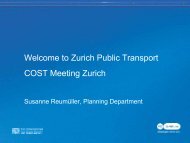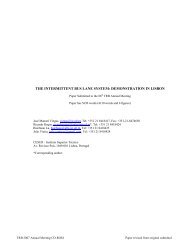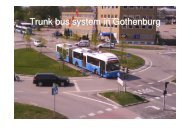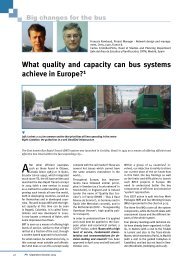THE ZUIDTANGENT - EXPERIENCES WITH BRT IN THE ...
THE ZUIDTANGENT - EXPERIENCES WITH BRT IN THE ...
THE ZUIDTANGENT - EXPERIENCES WITH BRT IN THE ...
You also want an ePaper? Increase the reach of your titles
YUMPU automatically turns print PDFs into web optimized ePapers that Google loves.
<strong>THE</strong> <strong>ZUIDTANGENT</strong> -<br />
<strong>EXPERIENCES</strong> <strong>WITH</strong> BHLS <strong>IN</strong><br />
<strong>THE</strong> AMSTERDAM REGION<br />
COST - BHLS<br />
13th October 2010<br />
David van der Spek<br />
Sr. Public Transport Policy Advisor<br />
Stadsregio Amsterdam
Agenda Inhoud<br />
• Background<br />
• History<br />
• System characteristics<br />
• Bus lane and bus way<br />
• Vehicles and stops<br />
• Identity<br />
• Patronage<br />
• Problems<br />
• 2nd route<br />
• Future developments<br />
• Conclusions
Background Inhoud<br />
• Shift in town planning: new housing and<br />
office sites in suburban areas<br />
• Increasing congestion on roads<br />
• Major international airport (5th busiest in Europe)<br />
• Priority to accessibility of this area for economical<br />
reasons<br />
• Existing rail orientated towards Amsterdam<br />
• Insufficient quality of existing orbital PT<br />
• Major flower exhibition in summer 2002<br />
Thus:<br />
• Urgent need for high quality orbital link<br />
• Estimated demand insufficient for light rail
1st Zuidtangent route<br />
148.000 inh.<br />
756.000 inh.<br />
(incl. Zuid-Oost)<br />
70.000 inh.<br />
30.000 inh.<br />
Schiphol Airport<br />
80.000 inh.<br />
80.000 inh.
History Inhoud<br />
• 1987 first study<br />
• 1994-2001 construction<br />
• Total investment 270 million Euro (95-100%<br />
funded by national government)<br />
• January 2002: start of 1st route<br />
• Contract awarded to incumbent operator<br />
Connexxion<br />
• 2007: Connexxion (Transdev) wins tender<br />
• December 2007 start of 2nd stage: 2nd route,<br />
new buses, new 8 year contract
Parties Inhoud involved<br />
• Stadsregio Amsterdam: responsible PTA for<br />
whole route except section in Haarlem<br />
• Province of Noord-Holland: responsible PTA<br />
for section in Haarlem, owner of the bus way,<br />
responsible for maintenance<br />
• Local municipalities: owner of local bus<br />
infrastructure<br />
• Connexxion: operator of<br />
regional bus network,<br />
revenue based contract
System characteristics Inhoud (1)<br />
• Ambition: high quality public transport, filling the gap<br />
between regular buses and light rail<br />
• 1st route: total length 41 km, core section 24 km<br />
• In core section bus lanes and independent bus ways<br />
• Elsewhere bus lanes<br />
where possible<br />
• High flexibility: adapts to<br />
space constraints in historic<br />
town centre of Haarlem<br />
• Several connections<br />
to heavy rail network
System characteristics Inhoud (2)<br />
• High service frequency (10 buses/h on weekdays)<br />
• From December 2007 operational 24/7<br />
• High commercial speed (>35 km/h)<br />
• Long average distance between stops (1.9 km)<br />
• Consistent identity (vehicles, stops, publicity)<br />
• ITS:<br />
– priority at traffic signals<br />
– dynamic passenger information system<br />
• Short dwell times:<br />
– minimal horizontal and vertical gap<br />
– no ticket inspection when boarding
Bus lane and bus way<br />
• No technical guidance system<br />
• Fully accessible to conventional buses,<br />
mixed operation possible<br />
• Designed and built to enable<br />
future conversion to light rail<br />
• Concrete surface<br />
• Several elevated sections<br />
• 1,8km tunnel section
Vehicles and stops<br />
• Dedicated fleet of 45 articulated 100% low floor<br />
Mercedes Citaro buses<br />
• Diesel, Euro 5-emission level<br />
• Capacity 46+55<br />
• From regular production<br />
• Core section: bus floor and<br />
stop at the same level<br />
• Physical guidance at stops:<br />
profiled kerbstones<br />
minimizing horizontal gap<br />
• Park-and-ride facilities<br />
for cars and bicycles
Identity<br />
• Buses in striking red livery<br />
• Designer stops along<br />
core section<br />
• Uncompromised identity:<br />
none of the design<br />
elements repeated<br />
elsewhere
Patronage (1st route)<br />
• 32.000 passengers per day (March 2009)<br />
• Heaviest loadings in Hoofddorp: 13.500 passengers<br />
per day (both directions)<br />
• 2005: patronage up to 99%<br />
higher than estimated<br />
• Eastern section below<br />
estimates during first years<br />
• Use of PT increased since<br />
Zuidtangent operating<br />
(up to 47% in first 3 years)
Passenger kilometres<br />
2003 - 2009<br />
Reizigerskilometers (in miljoenen)<br />
120<br />
100<br />
80<br />
60<br />
40<br />
20<br />
0<br />
SRA PNH Totaal<br />
2003 2004 2005 2006 2007 2008 2009
Knelpunten Problems<br />
• Subsidence of bus way: physical guidance at some<br />
stops blocked<br />
• Concrete surface less comfortable than asphalt<br />
• Weather protection at stops not satisfactory<br />
• Roofs at stops removed after problems during storm<br />
• Slippery surface at stops<br />
• Fare evasion<br />
• Implementation of ITS<br />
delayed for some years<br />
• Congestion on<br />
motorway section
Knelpunten 2nd route<br />
• Concept of 1st route not fully applied<br />
• Northern section:<br />
– no new infrastructure built<br />
– service not always reliable due to congestion<br />
– limited demand because of parallel railway<br />
• Southern section:<br />
– no new design for stops available<br />
– stops without BHLS identity<br />
– bus way opened after delay<br />
• Patronage on northern section<br />
disappointing, service<br />
cut back after 1st year
Future Knelpunten developments<br />
• Stops to be improved<br />
• Upgrading of eastern section: more bus lanes<br />
• New branches and extension planned<br />
(but longer route is risk to reliability!)<br />
• Conversion to light rail<br />
depending on patronage<br />
• High quality bus routes<br />
to be introduced<br />
in other areas
Conclusions<br />
Knelpunten<br />
• Successful concept: high commercial speed, high<br />
service frequency, high flexibility, high reliability<br />
• Result: patronage higher than estimated<br />
• Lessons:<br />
– BHLS only works if uncompromised<br />
– Stops: functionality more important than design<br />
– More attention to quality of infrastructure needed<br />
– Maintaining high quality means continuous effort from all<br />
parties<br />
• BHLS is able to increase the share of public transport<br />
• The choice for BHLS with proven technology has<br />
been the right one!
Thank you for your<br />
attention!


